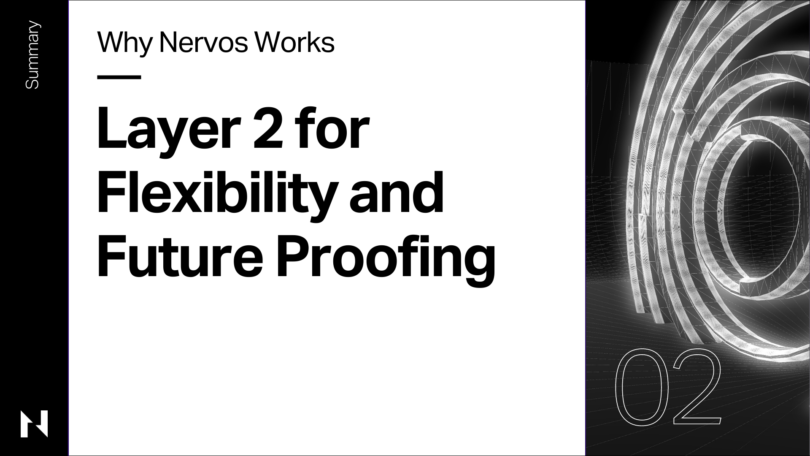One of the key goals Nervos has always aimed for is developer flexibility and future-proofing which leads to a network that can offer users a vast array of blockchain potential. Nervos’ path to achieving this is through its layered architecture; Layer 1 for optimal security and decentralization, and Layer 2 for flexibility and future-proofing.
This platform construction is what makes Nervos work, and lends it to be inherently multi-chain – another important goal of the network. Having a solid Layer 1 – the Common Knowledge Base – with a Layer 2 that is independent and interdependent means much of the current blockchain issues have already been solved.
This layered approach means Nervos has the ability to store assets, like Bitcoin, but it also has smart contract capabilities, like Ethereum. So, while the Layer 1 blockchain verifies and stores states, the computation-intensive state generation happens on Layer 2.
Let’s dive into Nervos’ Layer Two
Sitting on top of the Common Knowledge Base is Layer 2. This layer is reserved for other functions requiring high throughput. It offers the best scaling options, providing nearly unlimited transactional capabilities, minimal transaction costs, and an improved user experience.
This should also lead to a greater array of functionality for dApps because Layer 2 networks can be designed to suit their use. Layer 2 offers endless opportunities for customization and even allows for application-specific trade-offs over trust models, privacy and finality.
It is easy to see how scalability can be solved with a Layer 2 architecture, but flexibility and future-proofing also come into it as there can be multiple Layer 2s built upon Nervos, all with their own customization possibilities.
The first Layer 2 blockchain on nervos has already been built and is an EVM-compatible Layer 2 blockchain. Secured by Nervos’ Layer 1 through the use of an optimistic roll-up, this Layer 2 ensures high throughput and security.
Combined with Ethereum Virtual Machine support, this Layer enables developers to employ Ethereum contracts while keeping transactions scalable, fast, and low-cost. It also means developers can port their existing dApps running on Ethereum to CKB with minimal effort.
Full on Flexibility
This Layer already shows how much flexibility there can be on Nervos for Developers.
For the busy app craftsmen, it is a one-stop solution, where they can directly leverage the Layer 2 EVM-powered blockchain to ship whatever they want. For example, what if we told you, Uniswap can be deployed to CKB with just a minimal amount of tweaking?
CKB also provides Lego style pieces, which developers can disassemble and reassemble. If you choose not to write smart contracts via Solidity, you can build your own VM on the Layer 2 for a different rollup chain. There is no need to just use an optimistic rollup, you can take that out and swap in a more challenging piece, such as ZK Rollup. It can even offer different consensus mechanisms.
Additionally, this flexibility lends itself to Nervos being future-proof. Current limitations on other blockchains can be overcome on Layer 2 as the flexibility allows for solutions to scalability etc. As new ways to optimize blockchain and make it more workable are thought up, they can be implemented on a Layer 2 utop Nervos’ solid Layer 1.
User Defined Tokens
Of course, blockchain flexibility needs to come with cryptocurrency flexibility, and with the Nervos Layer 2 so comes User Defined Tokens (UDTs) we are constantly working to create better, and more complex possibilities in the UDT space.
With sUDTs — which are tokens that can be easily created by users to tokenize assets while being secured on Nervos’ CKB Layer One blockchain — Nervos also offers the ability to create xUDTs.
xUDT (or Extensible User defined Tokens) allows for definition of more functionality and rules that a user-defined token may need. In other words, xUDT is an extension on sUDTs for defining more behaviors a UDT might need.
A World of Possibilities
At its core, the layered architecture of Nervos is what makes it work. The platform takes the best out of a blockchain like Bitcoin on Layer 1 and ties it with the best that Ethereum has to offer in Layer 2. More than this though, having this secured Layer 2 offers incredible flexibility, and is the basis of Nervos’ multi-chain approach.
This is the second in a four-part series that breaks down the architecture of Nervos and why it works as a blockchain platform for today, and into the future, Stay tuned for part 3: Why Nervos Works: Multi-chain for Internet-like Interoperability.
To stay updated on all things Nervos:
Join our community: Discord — Github — Nervos Talk Forum — Twitter
For discussions or questions join the conversation on Discord or check out one of our community Telegram channels: English, Korean, Russian, Japanese, Spanish, Vietnamese and Chinese
